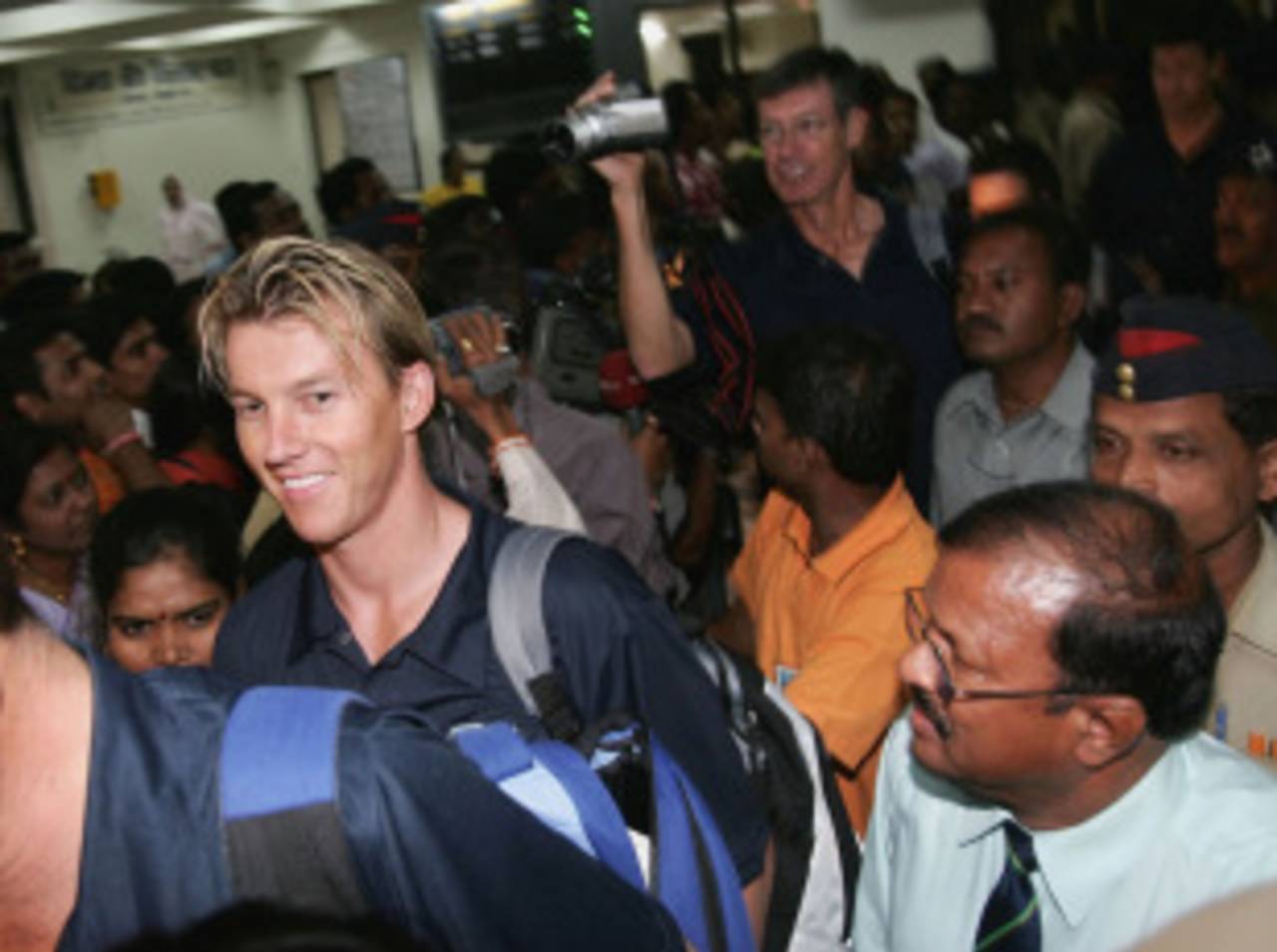Oranges are not the only fruit
It's not pretty like Bangalore, cosmopolitan like Mumbai or politically important like Delhi. But Nagpur loves cricket, welcomes tourists, and breeds super-strong mosquitoes
Christine Davey
17-Nov-2010

Australian cricketers mobbed on their arrival at the Nagpur airport in 2004 • Getty Images
Arriving at 1.30am is never an ideal introduction to a city. After a 15-hour train journey from Agra, I lobbed into Nagpur, glimpsing the aesthetically uninspiring buildings of the central business district through half-closed eyes.
It was October 25, 2004, the day before the third Test between Australia and India. No one knew it at the time, but this game would be the clincher; the first series win for Australia in 35 years. After a decisive Australian win in Bangalore, the circus of players, media, and a smattering of dedicated Aussie fans, moved onto Nagpur for the duration.
"What's Nagpur like?" a friend had asked before I left home. "Isn't it famous for oranges?" At 1.30am, alone on a railway platform, the answers, orange-based or otherwise, weren't forthcoming.
A tuk-tuk driver took me to a hotel, assuring me during the hair-raising, five-minute trip through winding back alleys that the chosen establishment was clean and safe.
After what seemed like several days of administrivia, involving the microscopic inspection of my passport, the assiduous investigation of my travel documents, and if I remember correctly through a haze of sleep deprivation, a promise to hand over my first-born, I was shown to my room.
It was clean and safe. It was also teeming with mosquitoes, courtesy the two-metre hole in the street-facing wall. Not deterred by trivialities, my host spread newspaper across the hole and fastened it with gaffer tape. "Is good now, lady," he smiled. "No more mosquitoes."
Be warned. Nagpur mosquitoes are made of stern stuff. Gaffer-taped newspaper was no match for their tenacity. I spent the rest of the night with head under sleeping bag blocking out the buzz of bloodsuckers determined to gorge on my antipodean life force.
After a few hours I gave up attempts at sleep, ripped the newspaper from the wall and let the sounds and smells of my first daylight experience of Nagpur pour through the makeshift window.
Even at 6am the horn toots of cars, buses and trucks were in supersonic over-drive. The street below was bustling, congested with children, workers, stall-holders, and the occasional aimlessly wandering Australian decked out in green and gold.
The cricket was in town. Nagpur might not have been on the traditional tourist route, might not have been as pretty as Bangalore, as cosmopolitan as Mumbai, as politically important as Delhi, but it was seizing its moment in the sun.
A bumpy tuk-tuk ride brought me to the Vidarbha Cricket Association Stadium, a concrete behemoth around which a line of humanity was already snaking, edging its way restlessly towards the ticket booth. Everyone - men, women, young and old - had come to watch the Indians and Australians battle for the Border-Gavaskar Trophy.
The locals of Nagpur welcomed Aussie fans with high-fives, jovial banter, requests for autographs and, much to my eternal gratitude, a copious supply of freshly brewed coffee.
"Black, strong, no sugar," the teenager operating the mobile coffee stall repeated my order. "I'll have it ready for you every morning." Yes, I thought. This was a lifestyle to which I could become accustomed.
I sat next to a schoolgirl, who explained she'd never met an Australian before. "I want to see a kangaroo," she said, dismayed that I didn't carry a photo of said marsupial in my wallet
The atmosphere inside the stadium was festive. Music blared from the public address system. Fans displayed their handwritten signs for the TV cameras - "We Love Sachin", "VVS, Very, Very Special", "Ricky Ponting go home".
Security guards patrolled the boundary fence, steely eyes trained on potential troublemakers, pitch invaders and/or drunken Australians prepared to disturb the peace. In the terraces of the Billimoria Pavilion, I sat next to a schoolgirl, who explained she'd never met an Australian before. "I want to see a kangaroo," she said, dismayed that I didn't carry a photo of said marsupial in my wallet.
Finally, as the humidity rose and the crowd cheered, Adam Gilchrist won the toss, elected to bat and the game was afoot.
For those who've never witnessed cricket in India, any description is inadequate. It is noisy and unexpected, grand and grotesque. The fans are uninhibited in their enthusiasm for the game they love.
On this first day of this Test, the fans were also unfailingly friendly. A family in the row below offered me half their lunch. A young boy in the row behind asked whether I could pass on Shane Warne's email address. A mother showed me photos of her daughter's graduation ceremony from teacher's college.
In the end, Australia won the Test match in four days. In the end, I didn't get to see much of Nagpur, other than a concrete behemoth and a mosquito-infested hotel room. In the end it didn't matter. The essence of Nagpur was all around me in the terraces of the Billimoria Pavilion.
"What was Nagpur like?" my friend asked when I returned home. "It's famous for oranges," I said. "And mosquitoes that can eat through steel."